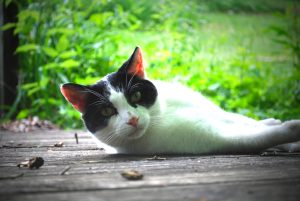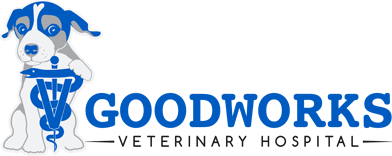Surgery
We perform a variety of different surgeries from routine spays and neuters to complex and life threatening surgical emergencies. Goodworks offers in-house pre-anesthetic blood screening for the utmost in safety and this blood screening is recommended for all patients undergoing anesthesia. Check out our Lab Services to see how we can help your pet! This blood screening ensures that your pet is healthy enough to receive anesthetics by checking parameters related to kidney and liver function. It also checks values related to blood cells. The anesthetics administered are specifically tailored to your pet and depend upon your pet’s health status and procedure(s) to be performed.
We have state of the art equipment for monitoring your pet during surgery. We monitor your pet's heart rate & rhythm, oxygen saturation, respiration, temperature, and blood pressure. More important than the equipment, however, is active monitoring by trained personnel. Goodworks employs highly skilled registered veterinary technicians that will ensure all surgical patients are closely monitored and given intensive care through anesthesia and the recovery phase.
 Furthermore, intravenous (IV) fluid therapy is standard for all patients during surgery. Providing IV fluids while under anesthesia allows us to intervene quickly and immediately if a pet has any anesthetic abnormalities such as a dangerous drop in blood pressure or heart rate. The fluid rate can be adjusted as necessary and emergency drugs can be administered without having to place an IV catheter under an emergency situation. In addition to fluid therapy, each patient will be placed on a warm water bed during surgery to help maintain core body temperature. This improves circulation and aids in the speed of recovery from anesthesia.
Furthermore, intravenous (IV) fluid therapy is standard for all patients during surgery. Providing IV fluids while under anesthesia allows us to intervene quickly and immediately if a pet has any anesthetic abnormalities such as a dangerous drop in blood pressure or heart rate. The fluid rate can be adjusted as necessary and emergency drugs can be administered without having to place an IV catheter under an emergency situation. In addition to fluid therapy, each patient will be placed on a warm water bed during surgery to help maintain core body temperature. This improves circulation and aids in the speed of recovery from anesthesia.
We strive to remain at the forefront of the veterinary medical field and to provide your pet with the highest quality medical care.
Surgeries that we perform include (but are not limited to) the following:
An umbilical hernia is a defect in the body wall at the umbilicus which can allow fat or other abdominal contents such as intestines to protrude from the abdominal cavity. These occur when the opening that allows passage of nutrients from mother to offspring fails to close at birth. In most instances, umbilical hernias are small and can easily be repaired at the time of spay or neuter. However, in larger umbilical hernias intestines can become entrapped outside the body wall. If this occurs and causes an intestinal obstruction or impedance to blood flow, emergency surgery is required.
An inguinal hernia is an opening in the body wall in the groin region and can be congenital or caused by trauma. As with umbilical hernias, these can allow organs to become entrapped. An inguinal hernia is especially serious for a pregnant female as the uterus can become entrapped outside the body wall. As the uterus enlarges with pregnancy, it can cause the inguinal hernia to enlarge. In young animals, as long as no signs of organ entrapment are present, these can also be repaired at the time of spay or neuter.
Both umbilical and inguinal hernias are considered an inherited trait which can be passed to offspring. Thus, these animals should not be used for breeding.
A caesarean section (known as a C-section) can be performed to remove fetuses from the uterus when a pregnant female is having difficulty giving birth. Difficulty giving birth is called dystocia. The goal of this surgery is to remove puppies or kittens as quickly as possible to maximize survival of the offspring. C-sections are commonly performed on an emergency basis, but can also be scheduled in breeds know to have difficulty such as English bulldogs, or in females with a history of dystocia. A spay can also be performed at the time of C-section if no further breedings are desired. When planning to schedule a C-section, it is best to work closely with your veterinarian before breeding.
The medical terminology for a “spay” is ovariohysterectomy. This means to remove both ovaries and the uterus. This permanently prevents pregnancy and future heat cycles. The term “neuter” is commonly synonymous with castration in a male. The medical terminology for castration is orchiectomy. This prevents a male from impregnating a female by removing both testicles. Both surgeries are recommended in cats and dogs at around 4-6 months of age. Spaying a female before the first heat cycle greatly reduces the risk of mammary cancer. Neutering a male eliminates the risk of testicular cancer and also helps prevent aggression and roaming.
Tumors, which are also called masses, on the surface of the body are very common as pets age. They can arise in almost any location and can be benign (meaning confined to one place) or malignant (spreading to distant sites in the body.) Any mass should be evaluated by your veterinarian as soon as it is noticed. All masses are easiest to remove when they are the smallest. Removing masses when small also decreases post-operative pain for pets and maximizes the chances of complete removal of any cancerous cells. Once removed, a mass can then be sent to a pathologist for further diagnostics.
Amputations can be necessary for limbs, digits, tails, or other body parts that have undergone severe trauma in cases where healing to normal function or resumed comfort are not expected. Amputations can also be necessary in the case of certain cancers. Amputation of any body part, including the tail, for cosmetic purposes alone is not recommended.
An abdominal exploratory means to open the abdominal cavity and search for the cause of a medical problem that can be surgically corrected. This surgery is only recommended in certain circumstances and after diagnostics such as bloodwork and radiographs have been performed. Often the veterinarian has a strong suspicion of the cause of the problem, such as a foreign object obstructing the intestinal tract, or a mass visible on radiographs. However, this surgery can be recommended when there is no strong suspicion and an animal is exhibiting vague clinical signs such as chronic vomiting. Many diseases can be diagnosed and possibly corrected during an abdominal exploratory. In addition, all the organs can be visually evaluated for normal shape, size, and consistency. Biopsies can be collected from any abnormal tissues and sent to a pathologist for diagnostics if indicated.
A “cherry eye” is a prolapse and swelling of the gland that lies within the third eyelid. The third eyelid is called the nictitating membrane. The prolapsed gland is not removed, but actually tucked back into position by making a partial incision through the membrane around it and suturing the tissue over top of the gland. Once the gland is tucked into position the swelling starts to resolve and the third eyelid appears normal again. By replacing the gland rather than removing it, this procedure won’t lead to dry eye.
A foreign body refers to anything that is lodged within the body that is not the tissue of the body. Examples of foreign bodies are plastic, string, or fabric lodged within the stomach or intestinal tract.
The most common reason to remove part of the bowel is from the trauma caused by a lodged foreign body. When a pet ingests something that cannot pass, that item can become lodged. When it lodges in the intestine it cuts off circulation and the bowel can die. Once this occurs bacteria will quickly enter the blood stream causing septicemia and eventually death. Upon diagnosis of a foreign body, immediate surgery is imperative. Any intestines that show signs of vascular compromise such as purple discoloration, odor, or torn tissue must be removed. The remaining ends of intestine are then sutured together.
Bladder surgery, known as cystotomy, is commonly performed to remove bladder stones, which are called calculi. In most instances the calculi will be sent for diagnostics and a prescription diet will be recommended by the veterinarian based on the composition of the calculi. It is important to feed this diet exclusively to prevent future calculi from forming. Bladder surgery can also be performed to remove bladder tumors depending upon their location.
The most common reason to remove the spleen is rupture of a tumor on the spleen. This usually causes life threatening bleeding into the abdomen. Because this usually happens suddenly, splenectomies are commonly performed on an emergency basis. Blood transfusions are often needed to correct severe blood loss anemia. Animals can live healthy lives without a spleen, but it is important to send the organ to a pathologist for diagnosis once removed.
A prophylactic gastropexy is a surgical procedure that involves tacking the stomach to the body wall to prevent a life threatening twisting of the stomach known as a GDV (gastric dilatation volvulus). This surgery is recommended in breeds predisposed to GDV and can be performed at the time of spay or neuter. In dogs that are already spayed or neutered the surgery can be performed at any time, but is recommended as soon as possible, as the risk of GDV increases with age in predisposed breeds. Breeds predisposed to GDV are large, deep chested dogs such as Great Danes, Weimaraners, Saint Bernards, German Shepherds, Irish and Gordon Setters, and Doberman Pinschers.
Gastric Dilatation Volvulus occurs most commonly in large deep chested dogs such as Great Danes, Weimaraners, Saint Bernards, German Shepherds, Irish and Gordon Setters, and Doberman Pinschers. This condition, sometimes referred to as “bloat” is a sudden disorder in which the stomach enlarges with air and rotates, cutting off circulation to the stomach. Signs of a GDV include walking in a hunched posture, pacing, a hard distended abdomen, and unproductive repeated retching. This is a surgical emergency and treatment must be initiated immediately. While the exact cause is unknown, GDV has been associated with several factors.
Recommendations to prevent GDV include the following:
-Feed several small meals a day rather than one large meal
-Avoid stress during feeding (if necessary separate dogs in multi-dog households)
-Restrict exercise before and after meals
-Do not use an elevated food bowl
-Do not breed dogs with a first-degree relative (parent, littermate, or offspring) that has a history of GDV
-Consider prophylactic gastropexy in at risk dogs
-Seek veterinary care immediately if any signs of bloat are noted
Entropion is a condition in which the eyelids roll inward and hair comes in contact with the surface of the eye. This condition occurs in a variety of breeds of dogs and also can occur in cats. Affected animals often have watery eyes, usually with a green ocular discharge. They show signs of discomfort by squinting and pawing at their eyes. In severe cases scarring of the surface of the eye can occur and impair vision. This condition can be corrected with a small skin incision and suturing near the margin of the eyelid.
Ectropion is a condition in which the eyelid rolls outward. This is seen in breeds that have excessive eyelid length such as Bassett Hounds. Because the eyelid is not in proper position against the eye, the surface of the eye can become dry, leading to trauma and scarring. This condition can be corrected by removing a portion of the excessive eyelid.
